高级微观经济学(经济类)AdvancedMicroeconomics
微观经济学

微观经济学(microeconomics)一、什么是微观经济学微观经济学又称个体经济学,小经济学,是宏观经济学的对称。
微观经济学主要以单个经济单位(•单个的生产者、单个的消费者、单个市场的经济活动)作为研究对象,分析单个生产者如何将有限的资源分配在各种商品的生产上以取得最大的利润;单个消费者如何将有限的收入分配在各种商品的消费上以获得最大的满足。
同时,微观经济学还分析单个生产者的产量、成本、使用的生产要素数量和利润如何确定;生产要素供应者的收入如何决定;单个商品的效用、供给量、•需求量和价格如何确定等等。
微观经济学——分析个体经济单位的经济行为,在此基础上,研究现代西方经济社会的市场机制运行及其在经济资源配置中的作用,并提出微观经济政策以纠正市场失灵。
微观经济学关心社会中的个人和各组织之间的交换过程,它研究的基本问题是资源配置的决定,其基本理论就是通过供求来决定相对价格的理论。
所以微观经济学的主要范围包括消费者选择,厂商进行的供给和收入分配。
微观”是希腊文“μικρο”的意译,原意是“小”。
微观经济学是研究社会中单个经济单位的经济行为,以及相应的经济变量的单项数值如何决定的经济学说。
亦称市场经济学或价格理论。
微观经济学的中心理论是价格理论。
微观经济学的一个中心思想是,自由交换往往使资源得到最充分的利用,在这种情况下,资源配置被认为是帕累托(Pareto)有效的。
二、微观经济学的主要内容微观经济学的主要内容包括:均衡价格理论、消费经济学、生产理论、厂商理论、分配理论和微观经济政策。
三、微观经济学的产生与发展微观经济学的历史渊源可追溯到亚当·斯密的《国富论》,阿尔弗雷德·马歇尔的《经济学原理》。
20世纪30年代以后,英国的罗宾逊和美国的张伯伦在马歇尔的均衡价格理论的基础上,提出了厂商均衡理论。
标志着微观经济学体系的最终确立"它的体系主要包括:均衡价格理论,消费经济学,生产力经济学,厂商均衡理论和福利经济学等。
微观经济学Microeconomics-精品课件

• 参考教材 :黄亚钧 郁义鸿主编 《微观经 济学》,高等教育出版社,2003年。
• 参考书目: • [美]H.范里安著 《微观经济学:现代观
点》,上海三联书店 上海人民出版社, 1994年; • [美]平狄克 鲁宾费尔德 著 《微观经济 学》,中国人民大学出版社,1997年。 • 黎诣远 《微观经济分析》,清华大学出 版社
13、He who seize the right moment, is the right man.谁把握机遇,谁就心想事成。21.7.1421.7.1 401:18:2501:18 :25July 14, 2021
•
14、谁要是自己还没有发展培养和教 育好, 他就不 能发展 培养和 教育别 人。202 1年7月 14日星 期三上 午1时1 8分25 秒01:18:2521.nomic Man 经济人
• 如果说,稀缺是社会存在的经济概括, 那么,经济人这个概念就是对社会意 识的经济学概括。
• 经济学并不研究稀缺本身,而是研究 在稀缺条件下人的行为,也就是研究 经济人的行为。
© copyrights by Changde Zheng 2004. Economic college,Southwest University For Nationalities.
ii) Scarcity means that to have more of some things there must be less of others (Opportunity Cost): Production Possibilities Frontier
iii) Scarcity implies choice
•
15、一年之计,莫如树谷;十年之计 ,莫如 树木; 终身之 计,莫 如树人 。2021 年7月上 午1时1 8分21. 7.1401:18July 14, 2021
微观经济学名词解释
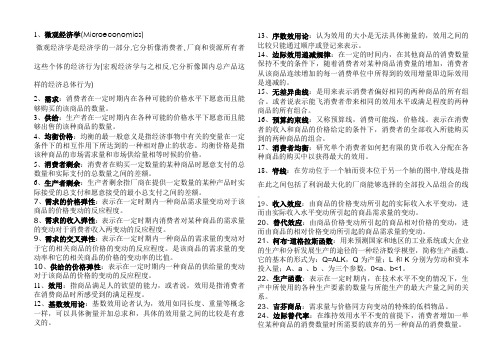
1、微观经济学(Microeconomics)微观经济学是经济学的一部分,它分析像消费者、厂商和资源所有者这些个体的经济行为(宏观经济学与之相反,它分析像国内总产品这样的经济总体行为)2、需求:消费者在一定时期内在各种可能的价格水平下愿意而且能够购买的该商品的数量。
3、供给:生产者在一定时期内在各种可能的价格水平下愿意而且能够出售的该种商品的数量。
4、均衡价格:均衡的最一般意义是指经济事物中有关的变量在一定条件下的相互作用下所达到的一种相对静止的状态。
均衡价格是指该种商品的市场需求量和市场供给量相等时候的价格。
5、消费者剩余:消费者在购买一定数量的某种商品时愿意支付的总数量和实际支付的总数量之间的差额。
6、生产者剩余:生产者剩余指厂商在提供一定数量的某种产品时实际接受的总支付和愿意接受的最小总支付之间的差额。
7、需求的价格弹性:表示在一定时期内一种商品需求量变动对于该商品的价格变动的反应程度。
8、需求的收入弹性:表示在一定时期内消费者对某种商品的需求量的变动对于消费者收入两变动的反应程度。
9、需求的交叉弹性:表示在一定时期内一种商品的需求量的变动对于它的相关商品的价格的变动的反应程度。
是该商品的需求量的变动率和它的相关商品的价格的变动率的比值。
10、供给的价格弹性:表示在一定时期内一种商品的供给量的变动对于该商品的价格的变动的反应程度。
11、效用:指商品满足人的欲望的能力,或者说,效用是指消费者在消费商品时所感受到的满足程度。
12、基数效用论:基数效用论者认为,效用如同长度、重量等概念一样,可以具体衡量并加总求和,具体的效用量之间的比较是有意义的。
13、序数效用论:认为效用的大小是无法具体衡量的,效用之间的比较只能通过顺序或登记来表示。
14、边际效用递减规律:在一定的时间内,在其他商品的消费数量保持不变的条件下,随着消费者对某种商品消费量的增加,消费者从该商品连续增加的每一消费单位中所得到的效用增量即边际效用是递减的。
高级微观经济学
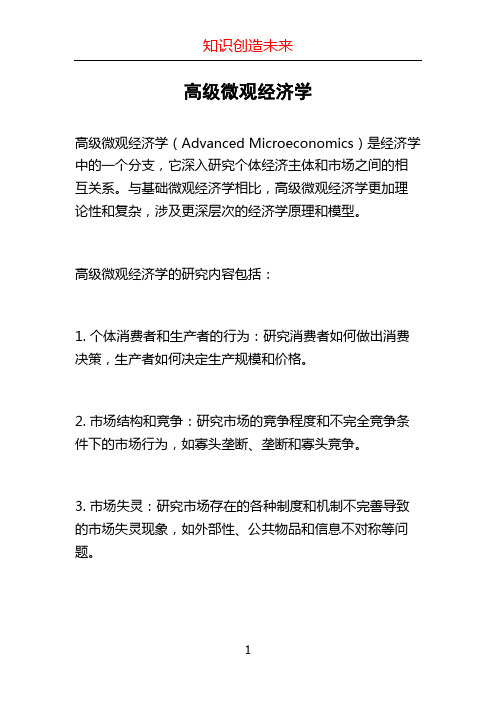
高级微观经济学
高级微观经济学(Advanced Microeconomics)是经济学中的一个分支,它深入研究个体经济主体和市场之间的相互关系。
与基础微观经济学相比,高级微观经济学更加理论性和复杂,涉及更深层次的经济学原理和模型。
高级微观经济学的研究内容包括:
1. 个体消费者和生产者的行为:研究消费者如何做出消费决策,生产者如何决定生产规模和价格。
2. 市场结构和竞争:研究市场的竞争程度和不完全竞争条件下的市场行为,如寡头垄断、垄断和寡头竞争。
3. 市场失灵:研究市场存在的各种制度和机制不完善导致的市场失灵现象,如外部性、公共物品和信息不对称等问题。
4. 游戏论和博弈论:研究个体之间的战略互动和决策过程,探讨不同策略下可能的结果。
5. 经济激励和合同理论:研究如何通过激励机制和合同设
计来引导经济主体的行为,如契约理论和机制设计等。
6. 不完全信息和不确定性:研究在信息有限和不确定性条
件下个体的决策行为和市场运行情况。
高级微观经济学的研究方法强调理论建模和分析,常常使
用数学和形式化的方法来描述经济行为和市场机制。
它是
经济学家、政策制定者和企业家等经济管理者理解经济现
象和制定决策的重要工具。
《高级宏观经济学》教学大纲(硕士研究生)-RonaldoCarpio

《高级宏观经济学》教学大纲(硕士研究生) - RonaldoCarpio《高级微观经济分析》教学大纲(博士研究生)课程代码:(按本专业或方向培养方案填写)课程名称:(按本专业或方向培养方案填写)英文名称:Advanced Microeconomic Analysis课程性质:(按本专业或方向培养方案填写)学分学时:3学分,48学时授课对象:金融学院一年级博士研究生课程简介:Based on Microeconomics I (for master students), the course will discuss thecontemporary development in microeconomics. This course is also designed to develop andextend the students’ analytical and reading skills in modern microeconomics. A student who haspassed the course should be able to read typical articles in the mainline journals, understand theanalytical derivations and arguments commonly used in the literature, and know how to solve themore widely used models.先修课程:Microeconomics for master students选用教材:1、 Mas-Colell, A., M. D. Whinston, and J. Green, Microeconomic Theory. (MWG)2、 Jehle, Geoffrey A. and Philip J. Reny, Advanced Microeconomic Theory. (JR)考核方式与成绩评定:Final Exam %; Midterm Exam %; Class Participation % 主讲教师:Carpio Ronaldo、颜建晔所属院系:金融学院联系方式:******************、*******************答疑时间及地点:求索楼123,Wednesday 13:30-14:30 (Carpio),Tuesday 15:00-17:00(颜)第一章:Consumer Theory教学目标和要求:Understand the consumer’s problem and consumer demand.教学时数:6学时教学方式:讲授准备知识:calculus教学内容:Preferences, Utility, and Consumer’s Problem第一节:Consumer’s Problem第二节:Indirect Utility, Demand作业与思考题:JR Ch 1.6参考资料:JR Ch 1, Appendix A1, A21第二章: Topics in Consumer Theory教学目标和要求:Understand duality, integrability, and uncertainty.教学时数:6 学时教学方式:讲授准备知识:statistics教学内容:Duality, Integrability, and Uncertainty 第一节:Duality of Consumer’s Problem第二节:Revealed Preferences & Uncertainty 作业与思考题:JR Ch 2.5 参考资料:JR Ch 2第三章: Theory of the Firm教学目标和要求:Understand the firm’s profit maximization problem.教学时数:6 学时教学方式:讲授准备知识:Chapter 1,2教学内容:Production, Cost, Profit Maximization 第一节:Production Functions & Cost第二节:Duality in Production, Competitive Firms 作业与思考题:JR Ch 3.6参考资料:JR Ch 3第四章: Partial Equilibrium教学目标和要求:Understand partial equilibrium markets. 教学时数:3学时教学方式:讲授准备知识:Chapter 3教学内容:Perfect & Imperfect Competition, Welfare 第一节:Competition 第二节:Equilibrium & Welfare作业与思考题:JR Ch 4.4参考资料:JR Ch 4第五章: Walras’/competitive equilibrium2教学目标和要求:competitive market economies from a Walrasian (general) equilibrium perspective.Let students understand “why the competitive market/equilibrium may work or fail?”教学时数:6学时方式:讲授教学准备知识:consumer theory, production theory教学内容:第一节:Walrasian economy and mathematical language of microeconomics 第二节:competitive equilibria of pure exchange and with production 作业与思考题:JR5.5, exercises of MWG Ch15, 18, 教师自编习题集参考资料:MWG Mathematical Appendix, Ch15, 18; JR5.4第六章: Social choice function/theory and social welfare: normative aspect of microeconomics教学目标和要求:When we judge some situation, such as a market equilibrium, as “good”or “bad”, or “better” or “worse” than another, we necessarily make at least implicit appeal to some underlying ethical standard. Welfare economics helps to inform the debate on social issues by forcingus to confront the ethical premises underlying our arguments as well as helping us to seetheir logical implications.Let students have a systematic framework for thinking about normative and social welfare topics.教学时数:3学时教学方式:讲授准备知识:Walrasian equilibrium教学内容:第一节:social choice, comparability, and some possibilities第二节:Rawlsian, Utiliterian, and flexible forms作业与思考题:JR6.5, exercises of MWG Ch21, 22, 教师自编习题集参考资料:MWG Ch21.A, Ch21.E, Ch22.C; JR Ch6第七章: Strategic Behavior and Asymmetric Information教学目标和要求:A central feature of contemporary microeconomicsafter Walrasian economy is the multi-agent interaction which represents the potential for the presence of strategicinterdependence. Let students grasp classic models of imperfect competition under symmetric and asymmetric information.3教学时数:3学时教学方式:讲授准备知识:perfect competition教学内容:第一节:monopoly and oligopoly under symmetric information第二节:oligopoly under asymmetric information作业与思考题:教师自编习题集参考资料:MWG Ch12; JR Ch4第八章: Theory of Incentives教学目标和要求:The strategic opportunities that arise in the presence of asymmetricinformation typically lead to inefficient market outcomes, a form of market failure. Underasymmetric information, the first welfare theorem no longer holds generally. Thus, the main themeto be explored is to stimulate different agents’ optimal/efficient behaviors in differentinformational settings to achieve the “second-best” market outcomes.教学时数:9学时教学方式:讲授准备知识:Strategic Behavior and Asymmetric Information教学内容:第一节:Adverse selection第二节:Moral hazard*第三节:Task separation/integration,第三节:Career concern作业与思考题:exercises of MWG Ch13, 14, 教师自编习题集参考资料:JR Ch8; MWG Ch13, 14第九章前沿研究讲座:待定邀请校外老师(待定)给学生们讲演最新研究,引导学生讨论;在学生掌握现代微观经济学基本模型之后能够接触到前沿研究。
《高级微观经济学Advanced Microeconomics》课件PPT-l
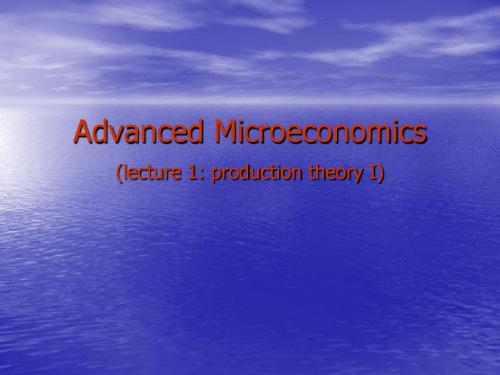
2.Properties of PS.
• Additive (free entrance) :
y Y,and y Y, then y y Y • Convexity: y Y,and y Y, then y (1 )y Y, here [0,1]
See the fig.
• Proposition1: if Y is convex, so is V(q). • Proposition2: if V(q) is convex, f(x) is quasiconcave.
lecture 1 for Chu Kechen Honors College
y Y, ay Y, a 0
lecture 1 for Chu Kechen Honors College
4.Returns to scale
• Proposition 3: Y is constant returns to
scale if Y is both “additive” and “convexity”. • Proposition 4: single production, if and only if f(.) is homogenous of degree 1, Y is constant returns to scale.
the array y y, and y Y means y Y • No free lunch: Y n {0}
n n
See the fig.
• Free disposal:
See the fig.
lecture 1
y n Y
for Chu Kechen Honors College
高级微观经济学-教学大纲
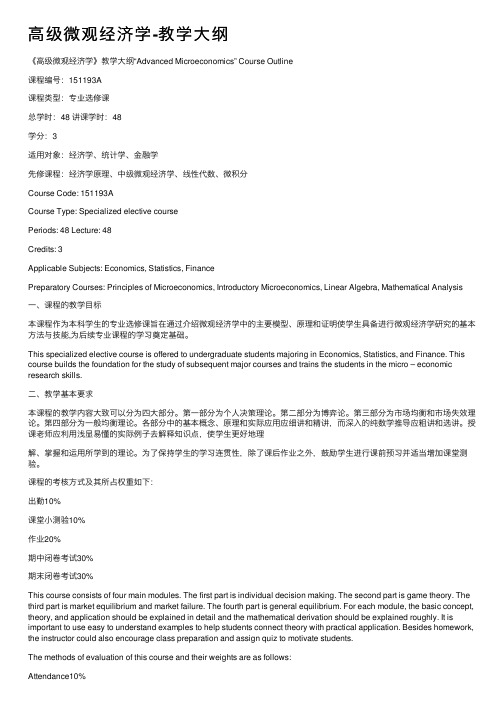
⾼级微观经济学-教学⼤纲《⾼级微观经济学》教学⼤纲“Advanced Microeconomics” Course Outline课程编号:151193A课程类型:专业选修课总学时:48 讲课学时:48学分:3适⽤对象:经济学、统计学、⾦融学先修课程:经济学原理、中级微观经济学、线性代数、微积分Course Code: 151193ACourse Type: Specialized elective coursePeriods: 48 Lecture: 48Credits: 3Applicable Subjects: Economics, Statistics, FinancePreparatory Courses: Principles of Microeconomics, Introductory Microeconomics, Linear Algebra, Mathematical Analysis⼀、课程的教学⽬标本课程作为本科学⽣的专业选修课旨在通过介绍微观经济学中的主要模型、原理和证明使学⽣具备进⾏微观经济学研究的基本⽅法与技能,为后续专业课程的学习奠定基础。
This specialized elective course is offered to undergraduate students majoring in Economics, Statistics, and Finance. This course builds the foundation for the study of subsequent major courses and trains the students in the micro – economic research skills.⼆、教学基本要求本课程的教学内容⼤致可以分为四⼤部分。
第⼀部分为个⼈决策理论。
第⼆部分为博弈论。
第三部分为市场均衡和市场失效理论。
《高级微观经济学》课件

公共支出
政府通过提供公共服务和基础 设施,弥补市场失灵,提高社 会福利。
监管和行政干预
政府对市场进行监管和行政干 预,防止垄断和不公平竞争。
市场失灵与政府干预的案例分析
环境污染案例
政府通过制定环保法规和排污标准,限制企 业排污,保护环境。
医疗保障案例
政府通过提供医疗保险和医疗救助,弥补市 场失灵,保障公民健康。
最优消费选择
在预算约束下,消费者选择能够最大化效用的商品组合。
边际替代效应
描述消费者在保持效用不变的情况下,一种商品对另一种商品的 替代程度。
消费者行为理论的扩展
风险偏好与不确定性
研究消费者在面临风险和不确定性时的消费行 为。
跨期消费选择
探讨消费者在不同时期之间的消费决策和储蓄 行为。
消费外部性
分析消费行为对其他个体或社会的影响,以及如何通过政策干预来改善消费行 为。
微观经济学的重要性
微观经济学是现代经济学的重要组成部分,它为政策制定者、企业家和消费者提供了理解和预测市场运作的基础 。通过研究微观经济学,人们可以更好地理解市场机制、价格体系和资源配置,从而做出更明智的决策。
微观经济学的基本假设和概念
基本假设
微观经济学通常基于一些基本假设, 如完全竞争、理性行为、完全信息等 。这些假设为理论分析提供了基础, 但在实际生活中可能并不完全成立。
公共选择理论与政治经济学
01
公共选择理论
研究公共物品和服务的供给和需求,以及政府决策的经济学分析。
02
政治经济学
研究政治和经济之间的相互作用,以及政治制度对经济发展的影响。
03
总结
公共选择理论和政治经济学是微观经济学的前沿领域,它们对于理解政
厦门大学 高级微观经济学AdvancedMicro1Midterm2016

SchoolofEconomics·WangYananInstituteforStudiesinEconomics
Advanced Microeconomics I
MIDTERM EXAMINATION
Fall, 2016
Instructions
• There are 4 questions in the exam. Please answer ALL of them. • Write your name, student ID, department and ALL answers on answer sheets. • NO calculator or references are allowed. • Any discussion or otherwise inappropriate communication between examinees, as
well as the appearance of any unnecessary material or cell phone usage, will be dealt with severely. • Good Luck!
Questions
1. Preference and Utility (25 marks) A consumer purchases two goods x1, x2 and his utility function is u(x1, x2) = [min(2x1 + x2, x1 + 2x2)]2 (a) Draw indifference curves on a graph. (3 marks) (b) Do the following properties hold for this utility function? Why? (i) Concave (3 marks) (ii) Quasi-Concave (3 marks) (iii) Homogeneous (If so, which degree?) (3 marks) (iv) Homothetic (3 marks) (c) Find the Marshallian demand for both goods. (7 marks) (d) Find the indirect utility function. (3 marks)
西方经济学微观部分名词解释
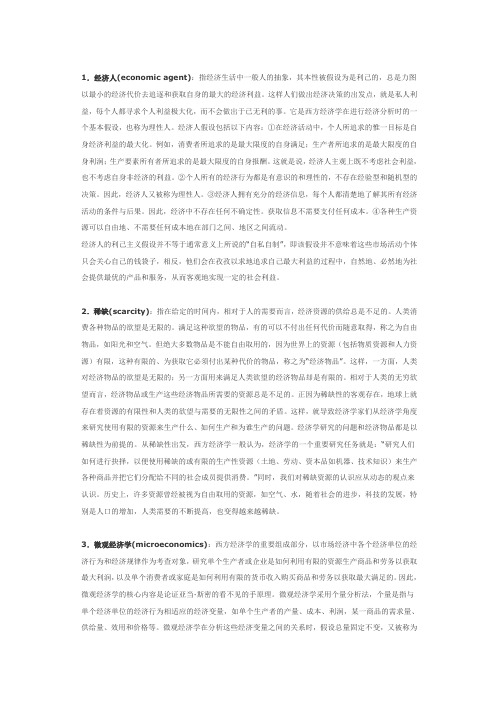
1.经济人(economic agent):指经济生活中一般人的抽象,其本性被假设为是利己的,总是力图以最小的经济代价去追逐和获取自身的最大的经济利益。
这样人们做出经济决策的出发点,就是私人利益,每个人都寻求个人利益极大化,而不会做出于已无利的事。
它是西方经济学在进行经济分析时的一个基本假设,也称为理性人。
经济人假设包括以下内容:①在经济活动中,个人所追求的惟一目标是自身经济利益的最大化。
例如,消费者所追求的是最大限度的自身满足;生产者所追求的是最大限度的自身利润;生产要素所有者所追求的是最大限度的自身报酬。
这就是说,经济人主观上既不考虑社会利益,也不考虑自身非经济的利益。
②个人所有的经济行为都是有意识的和理性的,不存在经验型和随机型的决策。
因此,经济人又被称为理性人。
③经济人拥有充分的经济信息,每个人都清楚地了解其所有经济活动的条件与后果。
因此,经济中不存在任何不确定性。
获取信息不需要支付任何成本。
④各种生产资源可以自由地、不需要任何成本地在部门之间、地区之间流动。
经济人的利己主义假设并不等于通常意义上所说的“自私自制”,即该假设并不意味着这些市场活动个体只会关心自己的钱袋子,相反,他们会在孜孜以求地追求自己最大利益的过程中,自然地、必然地为社会提供最优的产品和服务,从而客观地实现一定的社会利益。
2.稀缺(scarcity):指在给定的时间内,相对于人的需要而言,经济资源的供给总是不足的。
人类消费各种物品的欲望是无限的。
满足这种欲望的物品,有的可以不付出任何代价而随意取得,称之为自由物品,如阳光和空气。
但绝大多数物品是不能自由取用的,因为世界上的资源(包括物质资源和人力资源)有限,这种有限的、为获取它必须付出某种代价的物品,称之为“经济物品”。
这样,一方面,人类对经济物品的欲望是无限的;另一方面用来满足人类欲望的经济物品却是有限的。
相对于人类的无穷欲望而言,经济物品或生产这些经济物品所需要的资源总是不足的。
高级微观经济学讲义-577页文档
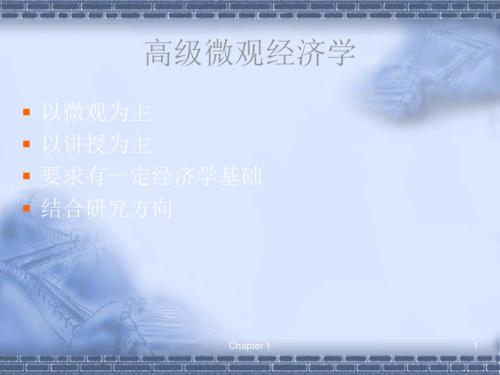
(PF = 1/2)
(PF = 2)
食物
40
80
120
Chapter 1
160 (单位/周)
28
预算约束
预算约束
• 两件商品和劳务
P X X P Y Y I,X 0 ,Y 0
• N件商品和劳务
P 1 X 1 P 2 X 2 P n X n I ,X i 0 , i 1 , 2 , n
O
50
C
Chapter 1
33
消费者偏好和无差异曲线
关于消费选择的基本假设
• 完备性假设:给定消费空间里任何一对消费组 合A和B,下列三者关系之一必成立:或者A>B, 或者B>A,或者A∽B。这意味着,消费者可以 在两组消费组合中作出一种明确的判断。
Chapter 1
34
消费者偏好和无差异曲线
预期、相关商品的价格 • 需求函数(求曲线) • 需求的变动和需求量的变动 • 需求规律(法则)
Chapter 1
15
经济学基础-需求和供给
供给
• 企业供给、市场供给 • 价格、生产技术、劳动、资本、原料等的投入
品价格 • 供给函数(供给曲线) • 供给的变动和供给量的变动 • 供给规律(法则)
Chapter 1
36
消费者偏好和无差异曲线
无差异曲线
无差异曲线代表了能给一个人相同程度满足 的市场篮子的所有商品组合。
无差异曲线包含了全体给予某消费者同等满 意程度的消费组合。
Chapter 1
37
消费者偏好和无差异曲线
衣服(单位/周)
50
B
40
H
比起蓝色方框中的任一市场篮子, 消费者偏好于市场篮子A; 而比起市场篮子A,消费者偏好于 粉红色方框中的任一市场篮子。 (“多比少好”的第三个假定)
高级微观经济学

高级微观经济学课本:参考书:1)Andreu Mas-Colell,Michael D. Whinston andJerry R. Green,1995,Microeconomic Theory,Oxford University Press;2)Hal Varian,Microeconomic Analysis,中译本,中译本:《微观经济理论》,经济科学出版社3)平新乔,微观经济学18讲,北京大学出版社1第一章:消费理论1.基本概念2.偏好关系和效用函数3.消费者的优化问题4.间接效用函数和支出最小化5.需求的特征本章属于经典消费理论。
其中大多数原理我们已经在中初级微观经济学中学习过。
但是在那里,这些原理来自于生活经验的归纳,而没有严格的证明。
本章的内容是严格的从消费者偏好开始通过数学推导出整个经典消费理论。
由于生产者和消费者是一对对偶,在行为上非常相似,因此,2有了严格建立在数学推导上的消费者理论和生产者理论就为整个微观经济学科学性有了保障。
本章的学习,重点在于理解现代微观经济学是如何从消费者偏好——效用函数——选择——需求建立起科学的消费者理论的。
34 1.1基本概念1、选择集/消费集X定义:所有可能的(能实现的和不能实现的)消费(选择)方案x 的集合。
消费方案x :商品:1) 商品数量无限可分: i x ∈ ,商品数量是连续的。
2) 商品数量非负:i x +∈3) 商品种类为:n消费束/组合(向量):()1,...,nn x x X +=∈=x5消费集X 特征:1、 非空集2、 闭集:p.429,定义A1.11(边界上的点能达到)3、 凸集:P.411,A1.2.24、 包含原点:X2、可行集B :制度约束、经济约束等3、偏好关系4、行为假设:在各种能够实现的消费方案中,消费者选择他最偏好的消费方案。
6 1.2、偏好关系和效用函数Debreu (1959)问题:1、无差异曲线为什么是我们常见的那种形状?2、怎样用一个函数描述偏好关系?1、偏好关系①、关系、两元关系:p.415-p.416 ②、两元关系的定义:定义在消费集X 上,反映X 中任意两个点之间的关系:12,X x x ,如果有12x x,则对该消费者而言,“1x 至少和2x 一样好”,或者,“在1x 和2x 之间,消费者弱偏好1x ”7公理一:完备性公理:对于选择集X 中任意的两个要素1x和2x ,有12x x 或21x x 含义:◆ 消费者能够做出对任何两个消费组合进行比较 ◆ 消费者具有无限的认知能力◆ 消费者具有无限的判断能力公理二:传递性公理:对于选择集X 中任何的三个要素1x 、2x 和3x ,如果12x x 和23x x ,则有13x x 。
Advanced_Macroeconomics
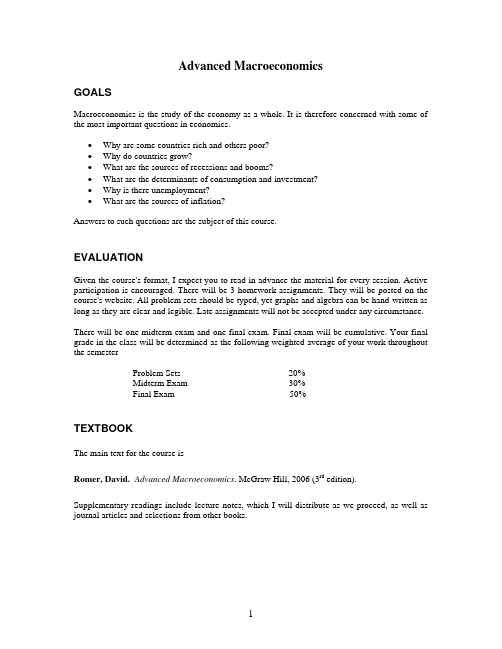
Advanced MacroeconomicsGOALSMacroeconomics is the study of the economy as a whole. It is therefore concerned with some of the most important questions in economics.∙Why are some countries rich and others poor?∙Why do countries grow?∙What are the sources of recessions and booms?∙What are the determinants of consumption and investment?∙Why is there unemployment?∙What are the sources of inflation?Answers to such questions are the subject of this course.EVALUATIONGiven the course's format, I expect you to read in advance the material for every session. Active participation is encouraged. There will be 3 homework assignments. They will be posted on the course's website. All problem sets should be typed, yet graphs and algebra can be hand-written as long as they are clear and legible. Late assignments will not be accepted under any circumstance. There will be one midterm exam and one final exam. Final exam will be cumulative. Your final grade in the class will be determined as the following weighted average of your work throughout the semesterProblem Sets 20%Midterm Exam 30%Final Exam 50%TEXTBOOKThe main text for the course isRomer, David. Advanced Macroeconomics. McGraw Hill, 2006 (3rd edition). Supplementary readings include lecture notes, which I will distribute as we proceed, as well as journal articles and selections from other books.COURSE OUTLINEMacroeconomicsI ModernBlanchard, Olivier. “What Do We Know about Macroeconomics that Fisher and Wicksell Did Not?” Quarterly Journal of Economics, November 2000, 115(4), pp. 1375-1409.Blanchard, Olivier. “The State of Macro.” Annual Review of Economics, 2009, 1, pp. 209-228. Kydland, Finn E. “Quantitative Aggregate Economics.” American Economic Review, December 2006, 96(5), pp. 1373-83.Phelps, Edmund S. “Macroeconomics for a Modern Economy.” American Economic Review, June 2007, 97(3), pp. 543-61.Woodford, Michael. “Revolution and Evolution in Twentieth-Century Macroeconomics.” Unpublished Manuscript, 1999.II GrowthThe Solow Growth Model, Romer Ch. 1Research and Development Models, Romer Ch. 3, Part ACross-Country Income Differences, Romer Ch. 3, Part BKenny, Charles and Williams, David. “What Do We Know About Economic Growth? Or, Why Don’t We Know Very Much?” World Development, January 2001, 29(1), pp. 1-22.Romer, Paul M. “The Origins of Endogenous Growth.” Journal of Economic Perspectives, Winter 1994, 8(1), pp. 3-22.Solow, Robert M. “Perspectives on Growth Theory.” Journal of Economic Perspectives, Winter 1994, 8(1), pp. 45-54.“The Solow–Swan Model”, Barro and Sala-i Martin, Chapter 1III Real Business CyclesReal-Business Cycle Theory, Romer Ch. 4“Real Business Cycles”, Ellen R. McGrattan(The note has been prepared for The New Palgrave Dictionary of Economics, 2nd edition)Rebelo, Sergio. “Real Business Cycle Models: Past, Present and Future.” Scandinavian Journal of Economics, June 2005, 107(2), pp. 217-238.FoundationsIV MicroeconomicThe Lucas Imperfect-Information Model, Romer Ch. 6, Part ANew Keynesian Economics, Romer Ch. 6, Part BInvestmentV ConsumptionandConsumption, Romer Ch. 7Investment, Romer Ch. 8Hall, Robert E. “Stochastic Implications of the Life-Cycle Permanent Income Hypothesis: Theory and Evidence.” Journal of Political Economy, December 1978, 86(6), pp. 971-987.VI Unemployment and InflationUnemployment, Romer Ch. 9 (9.1, 9.2, 9.3)Inflation and Monetary Policy, Romer Ch. 10 (10.1, 10.2, 10.3)Gilles, Saint-Paul. “Why Are European Countries Diverging in Their Unemployment Experience?” Journal of Economic Perspectives, Autumn 2004, 18(4), pp. 49-68. Orphanides, Athanasios. “Monetary-Policy Rules and the Great Inflation.” American Economic Review, May 2002, 92(2), pp. 115-120.Good Luck!。
微观经济学名词解释
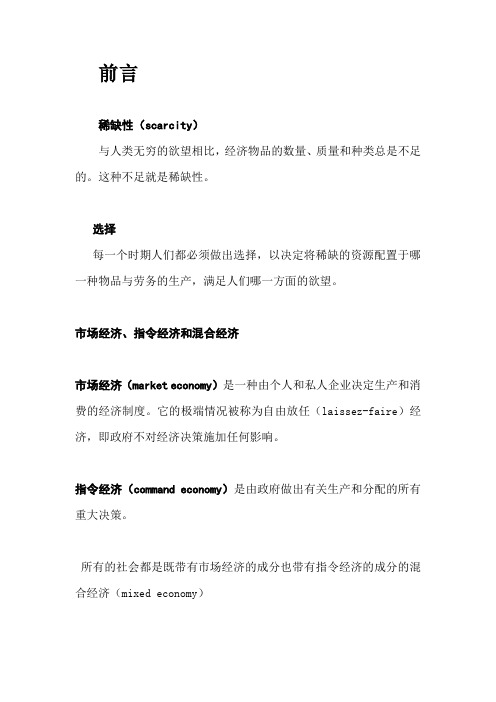
前言稀缺性(scarcity)与人类无穷的欲望相比,经济物品的数量、质量和种类总是不足的。
这种不足就是稀缺性。
选择每一个时期人们都必须做出选择,以决定将稀缺的资源配置于哪一种物品与劳务的生产,满足人们哪一方面的欲望。
市场经济、指令经济和混合经济市场经济(market economy)是一种由个人和私人企业决定生产和消费的经济制度。
它的极端情况被称为自由放任(laissez-faire)经济,即政府不对经济决策施加任何影响。
指令经济(command economy)是由政府做出有关生产和分配的所有重大决策。
所有的社会都是既带有市场经济的成分也带有指令经济的成分的混合经济(mixed economy)(微观)经济学的定义经济学(economics)研究的是一个社会如何利用稀缺的资源生产有价值的商品,并将它们在不同的个体之间进行分配。
微观经济学(microeconomics)以单个经济主体为考察的出发点,研究单个消费者、单个厂商、单个生产要素所有者的经济行为,并通过单个经济主体行为的叠加,研究单个行业、单个市场、以致整个国民经济状况的变化。
Microeconomics studies decision making by individuals and how their decisions determine the allocation of a society’s scarce resources.第二章消费者选择与需求消费者的偏好关系(consumer’s preference relation)是消费者根据自己的意愿,对可能消费的商品组合进行的排序。
消费者消费的商品组合(a basket of commodities)称为商品束,商品束可以由多种商品、也可以由一种商品组成。
例子:组合 x包含(x1,x2)两种商品,其中x1表示苹果的数量,x2表示电影票的数量。
“>”表示严格偏好或强偏好(strong preference);“≥”表示弱偏好(weak preference);“~”表示无差异(indifference)效用(utility)是指消费者在消费商品时所感受到的满足程度。
夏纪军-高级微观经济学讲义1
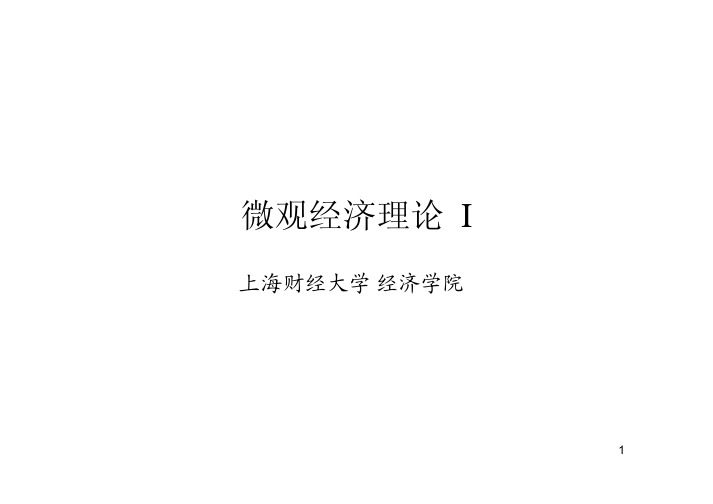
微观经济理论I上海财经大学经济学院1微观经济理论•参考书:–G. A. Jehle & P. Reny•Advanced Microeconomic Theory,–A. Mas-Colell, M. D. Whinston & J. R. Green •Microeconomic TheoryA. Rubinstein–A Rubinstein•Microeconomics Lecture noteVarian H R Microeconomic Analysis–Varian, H. R., Microeconomic Analysis2第一讲第讲偏好与选择31. 偏好与选择问题界定:选择函数(choice function)•(choice function)•偏好关系(preference relation)•显示偏好弱公理(weak Axiom of revealed preference)•理性选择与WA:选择函数的可合理化定理选择函数的可合理化定理41.1 选择函数择项•选择项:x–根据问题分析需要,设定个体可以选择的变量•比如–例1:利率或税收政策对消费会产生怎样的影响?•选项:x=(c1, c2)–例2:要素投入决策•选项:x=(k, l)–例3:地方政府基础设施投资激励•选项:x=(I i,C i )51.1 选择函数•选择项:x•选择集:X给定经济环境下,个体可以–想象自己可能选择的各种选择项的集合。
–根据经济环境设定每个变量可能的取值范围•例:•消费者选择集:={(0X {(c 1, c 2):c 1 0, c 2 0}•生产者选择集:X ={(k , l ):k 0, l 0}X 0•地方政府选择集:={(I i , C i ):I i 0, C i 0}61.1 选择函数•选择项:x•选择集:X•可行集:A X⊂–决策者可以选择的选项的集合–反映各种约束对选择的影响•例, c2):(1+r)c1+ c2≤(1+r)y1+ y2}消费者可行集{((1+)+(1+)+–消费者可行集:B={(c1–生产者可行集:B={(x1, x2):y≤f(k, l) }, C i):I i +C i ≤S+tF i }地方政府的可行集{(–地方政府的可行集:B={(Ii71.1 选择函数择项•选择项:x•选择集:X•可行集:A⊂X•D:可能的可行集的集合(X部分子集的集合)–例:–消费者可行集:B(r, y1,y2)–生产者可行集:B(ρ)–地方政府可行集: B(t, F,S)81.1 选择函数•例:大学的选择–可以申请的所有学校:X={x1,x2,..,x N}–A:接受申请的所有学校,可以从中选择一所接受申请的所有学校可以从中选择所–D:2N -1 种可能的选择情形(不考虑∅)•如果学校根据排名,从高到低进行了排序,而且排名高的学校录取了该学生,排名较低的学校都会录取。
高级微观经济学AdvancedMicroeconomics
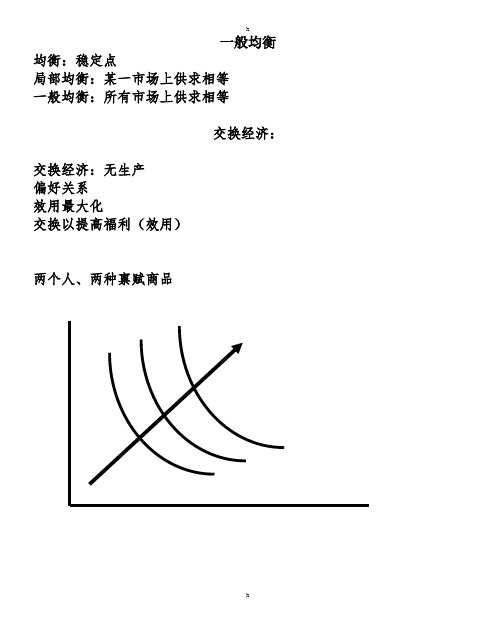
一般均衡均衡:稳定点局部均衡:某一市场上供求相等一般均衡:所有市场上供求相等交换经济:交换经济:无生产偏好关系效用最大化交换以提高福利(效用)两个人、两种禀赋商品Edgeworth 图 禀赋点为e假设自主交换能够实现帕累托改进,达到更优的配置点x对消费者1,其所偏好e 的区域为红色区域,最终的配置点必须在这一区域内,否则,他拒绝交换或抵制这一配置。
对消费者2,其所偏好e 的区域为蓝色区域,最终的配置点必须在这一区域内,否则,他拒绝交换或抵制这一配置。
因此,最终的配置点必须在重叠的区域中——凸透镜区域内和边上。
在这一区域里,双方或至少一方的福利能够提高。
11ee设交换后形成的配置点'x 在凸透镜内部,双方福利都得到改善,同时各有一条无差异曲线交于此点。
双方进一步通过交换改善彼此福利。
对消费者1,其所偏好'x 的区域为红色区域,最终的配置点必须在这一区域内,否则,他拒绝交换或抵制这一配置。
对消费者2,其所偏好'x 的区域为蓝色区域,最终的配置点必须在这一区域内,否则,他拒绝交换或抵制这一配置。
因此,最终的配置点必须在重叠的区域中——凸透镜区域内和边上。
在这一区域里,双方或至少一方的福利能够提高。
11ee'xh交换过程持续下去,凸透镜越来越小,最终变为一个点:两条无差异曲线的切点:x 。
此时,双方进一步交换会使某一方福利下降。
所以,双方的交换一旦达到了切点位置,就不会有交换发生。
实现了帕累托最优。
在凸透镜内部和边上,这样的点有无数多个,最终的配置究竟是哪一个点,我们并不知道,或者说,我们不知道决定最终的帕累托效率点的位置的因素是什么。
结论只是:帕累托效率点位于凸透镜边上或内部的某个切点位置上。
11eexEdgeworth图中,所有的无差异曲线的切点的连线构成契约线,帕累托效率点是凸透镜与契约线交集中的点。
2 11eexhh当禀赋点落在契约线上时,即为帕累托效率点,无交换发生。
高级微观经济学Advanced Microeconomic Theory讲义教案-Dynamic Games
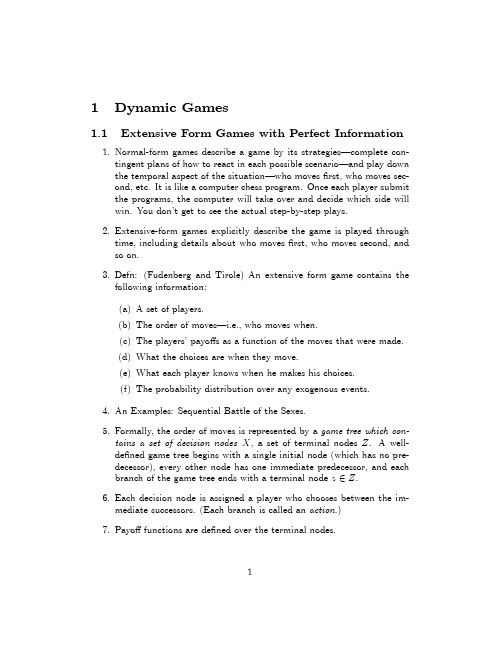
1Dynamic Games1.1Extensive Form Games with Perfect Information1.Normal-form games describe a game by its strategies—complete con-tingent plans of how to react in each possible scenario—and play down the temporal aspect of the situation—who moves…rst,who moves sec-ond,etc.It is like a computer chess program.Once each player submit the programs,the computer will take over and decide which side will win.You don’t get to see the actual step-by-step plays.2.Extensive-form games explicitly describe the game is played throughtime,including details about who moves…rst,who moves second,and so on.3.Defn:(Fudenberg and Tirole)An extensive form game contains thefollowing information:(a)A set of players.(b)The order of moves—i.e.,who moves when.(c)The players’payo¤s as a function of the moves that were made.(d)What the choices are when they move.(e)What each player knows when he makes his choices.(f)The probability distribution over any exogenous events.4.An Examples:Sequential Battle of the Sexes.5.Formally,the order of moves is represented by a game tree which con-tains a set of decision nodes X,a set of terminal nodes Z.A well-de…ned game tree begins with a single initial node(which has no pre-decessor),every other node has one immediate predecessor,and each branch of the game tree ends with a terminal node z2Z.6.Each decision node is assigned a player who chooses between the im-mediate successors.(Each branch is called an action.)7.Payo¤functions are de…ned over the terminal nodes.18.The information possessed by a player is represented by informationsets.Let X i denote the set of nodes where player i makes decisions.X i is partitioned into information sets.Players i can identify informa-tion set but not the nodes within an information set.For this to be meaningful,every information set must contain the same set of action.9.Defn:An extensive form game is of perfect information if every informa-tion set is a singleton(which means there is no exogenous uncertainty and each player also all the moves up to that point).10.A pure strategy of an extensive form game for a player i prescribes anaction at each information set of player i.Example.11.There are two ways to de…ne mixed strategies.A mixed strategy is aprobability distribution over mixed strategies.A behavioral strategy prescribes a probability distribution over actions in each information set.They are strategically equivalent in games of perfect information.1.2Backward Induction1.In order to determine what to do now,a player should…rst think aboutwhat he would do in the future.2.Backward Induction:Start with the decision nodes in the…nal stage(those whose successors are all terminal nodes)At each of these nodes, selects one of the best alternatives for the player who is making the decision and eliminates the rest.Repeat the same procedure until the initial node is reached.The resulting payo¤pro…le is called a backward induction solution.The solution is unique if no player is ever indi¤erent between two actions.3.It is a little odd that players are required to specify actions in infor-mation sets ruled out by her own action,since these info sets are never going to be reached no matter what other players are going to do.So, if a player wants to let an agent to play the game for him,there is no need to tell the agent what to do in those information sets.In fact,two strategies that are di¤erent only in info sets ruled out by own strategy are strategically equivalent in the sense they always lead to the same payo¤s.But a player needs to think about what he would do in a down-stream information set in order to decide what to do in an upstream2info set,even though his…nal decision in the upstream info set may be such that the downstream one is never going to be reached.So,this de…nition of strategy is not so odd when you interpret it as the way a player determines his strategy.1.3Examples of Backward Induction1.3.1Agenda Control1.There are three options:A,B,and C.Peter likes A better than B,andB better C.Paul likes B better C,andC better than A.Mary likes Cbetter A,and A better than B.To summarize:P eter:A B C;P aul:B C A;Mary:C A B:They…rst vote between A and B,and then they vote between C and the option that receives more votes in the…rst round.The option that receives more votes in the second round is adopted.How should they vote in each round,assuming no one ever votes for the option they like the least?2.If A wins the…rst round,in the second round Paul and Mary bothprefers C to A,so C will win in the second round.If B wins the…rst round,in the second round Peter and Paul prefers B to C,so B wins.By backward induction,the…rst round is actually between B and C (voting for A in the…rst round is tantamount to voting for C).Both Peter and Paul should vote for B in the…rst round.The…nal outcome is B.3.Note that Peter votes B over A in the…rst round,even though heactually prefers A to B.By controlling the agenda,any of the three outcomes can be made into the equilibrium outcome.1.3.2Finitely Repeated Prisoner1.For example,suppose the PD game is repeated for a…nite number oftimes.Obviously both players will choose d in the last period regardless3of the actions chosen in the penultimate period.Since their actions of the penultimate period does not a¤ect that in the last,the players again will choose d in the penultimate period.By the same logic,the players choose d in every period.1.3.3Tigers1.There are n hungry,cannibalistic lions.One of them,as a result of astrange disease,is soundly asleep and defenseless.Any lion can eat the sick lion but in that case it will get sick and fall asleep.These lions never share food and only one can eat at a time.The preference of the lions are as follows:eat a sick lion and stay alive stay alive got eaten by another lion.(They don’t care whether they are awake.) What is the backward induction solution of this game?1.3.4Dollar Auction1.The game Dollar Auction was invented by Martin Shubik,then a re-searcher at RAND.The game is very simple:Each bidder submit bids for a one-dollar bill.Each new bid must top the current high bid.Bid-ding continue until no new bids arrive.The highest bidder wins the dollar bill,and all bidders pay the auctioneer their…nal bids.2.Without knowing the actual equilibrium,it is obvious that in any equi-librium,at most one person should bid and no one should bid more than a dollar.In actual plays,however,bidding often goes past a dol-lar,yielding a pro…t to the auctioneer.3.Here we consider a modi…ed version of the game:Two risk-neutralplayers take turns to bid for a prize worth$100.At t=1,bidding begins at$0.In each round,one player decides whether to raise her bid by$1.(The increment is…xed at$1;that is,no jump bids.)The game ends when one player quits.The player with the higher bid wins $100,but both players have to pay their bids.For example,if Player1 bids x and Player2refuses to bid x+1,then Player1’s payo¤is100 x and Player2’s payo¤is (x 1)(the last bid he made).If the player moving…rst quits immediately,then the one who moves second wins.the players have a credit constraint of$1000;therefore,the game lasts no more than1000periods.(The player who bids$1000must win.)44.Suppose Player1bids…rst and Player2bids in period1000.At t=1000;if Player2bids$1000,her payo¤is $900;if she quits,her payo¤is $998.The optimal response is to bid$1000.Given that Player2 will bid for sure in period1000,Player1’s best response in period999 is to quit.Given that Player1will quit in period999,Player2will bid $998in period998....The backward induction solution is therefore to bid in all even periods and quit in all odd periods.1.4Nash Equilibrium1.For every extensive form game,we can write down a reduced normalform game of the extensive game by collapsing all strategically equiva-lent strategies into one.Two extensive form game strategies are strate-gically equivalent if they always lead to the same payo¤s(for all players) regardless of the actions of the other players.2.The reduced normal of the sequential battle of the sexes is:Player2Player1aa ab ba bb a3,13,10,00,0 b0,01,30,01,33.The reduced normal form however does not capture all the information,namely,the order of moves,contained in an extensive form game.Two extensive form games may have the same normal form.For,example, the game above may also be a2x4simultaneous-move game.4.Nash Equilibrium is de…ned in the usual way.5.The backward induction solution is a Nash equilibrium,but the con-verse is false.1.5Incredible Threats1.One day,some stranger on the street threatens to kill himself right infront of you(he has a knife)unless you give you all your money.Will you agree?52.You have two strategies:give(g)or not give(ng).The stranger needsto make two decisions:1)whether to commit suicide when you give him your money,and2)whether to commit suicide when you do not give him your money.So there are four strategies:ss,sn,ns,nn.3.You would rather give the stranger your money than to have him killhimself in front of you because the blood will ruin your expensive clothes,but you don’t want to give him money if he is not going to kill himself.You…gure that the stranger likes to have your money but doesn’t really want to die.4.Write down the game in extensive form.5.The game in reduced normal form:ss sn ns nng 1100; 1 1100; 1 100;100 100;100ng 1100; 10;0 1100; 10;06.There are three Nash equilibria in SBoS:(ng,sn),(ng,nn),(g,ns).7.The last equilibrium is what happens when you believe in the threatof the stranger.To prevent the person from killing himself,you give him your money.But note that threatening to kill himself when you don’t give up your money is a best response for the stranger when you believe in the threat because in that case the stranger does not need to carry out the threat.8.The second equilibrium is the backward induction solution.It capturesthe idea that the threat by the stranger is not credible.It is not a best response for the stranger to kill himself if you don’t give him your money.9.Backward induction suggests you should ignore the stranger.Nashequilibrium does not distinguish whether a threat is credible because as long as a threat is e¤ective,it has no payo¤consequences.10.But suppose before you can decide,the stranger cuts his arm and thenthreaten to kill himself unless you give him your money.The backward induction solution remains the same(that you should not give money)6but it also predicts that the stranger should not cut his arm.But now you see that the stranger has cut his arm,should you still believe in backward induction?11.There is no completely satisfactory solution to this question.12.Centipede Game1.6Games of Imperfect Information1.Backward induction does not work in games of imperfect information.Example.2.Defn:An extensive form game is of imperfect information if not allinformation sets are singletons.3.Subgame:The portion of the game tree that follows a decision node xis a subgame if it constitutes a well-de…ned extensive form game.That is,if1.the information set that contains x is a singleton and2.if x belongs to the subgame,then every x0in the same information set as x must also belong to the subgame.4.Subgame Perfection:A Nash equilibrium is subgame perfect if it pre-scribes a nash equilibrium in every subgame.5.Subgame perfection generalizes the idea of backward induction to gamesof imperfect information.The backward induction solution is always subgame perfect.6.The way to…nd subgame perfect equilibrium is similar to backwardinduction:starting from the subgame near the end and work backward.7.Example:OR227.17。
- 1、下载文档前请自行甄别文档内容的完整性,平台不提供额外的编辑、内容补充、找答案等附加服务。
- 2、"仅部分预览"的文档,不可在线预览部分如存在完整性等问题,可反馈申请退款(可完整预览的文档不适用该条件!)。
- 3、如文档侵犯您的权益,请联系客服反馈,我们会尽快为您处理(人工客服工作时间:9:00-18:30)。
课程大纲
高级微观经济学(经济类)
Advanced Microeconomics
课程编号:02810090 授课对象:研究生
学分:3 任课教师:孟涓涓
课程类型:必修开课学期:2017年秋季
先修课程:
上课时间:5-12周,每周两次课
周二2-4节(09:00-12:00)周三5-7节(13:00-16:00)
第一次上课时间:2017年10月10日
上课地点:光华老楼202
任课教师简历(500字左右):
孟涓涓,现任北京大学光华管理学院应用经济系和金融系副教授,她在美国加州大学获得经济学博士学位。
孟涓涓目前的研究专长包括行为经济学,行为金融学,劳动经济学,发展经济学等。
她的研究成果发表在国外顶级学术期刊上,如American Economic Review, Journal of Public Economics, Journal of Development Economics, International Economic Review, Games and Economic Theory, Journal of Economic Behavior and Organization.她目前主持国家自然科学基金面上项目“参照点和狭隘视野:行为经济学前沿问题探究” 和北京青年英才计划"依赖人际关系还是正式渠道---论正式与非正式制度安排对社会经济发展的影响"项目研究。
曾经主持国家自然科学基金青年基金研究项目“个体经济行为中的社会性因素”(已结题)。
孟博士曾获奖项有:光华管理学院最佳新人奖,2007-2008Excellence in Referee Reward, The American Economics Review,2001-2004北大明德奖学金等。
任课教师联系方式:
Email: jumeng@
电话:62754669
助教姓名及联系方式:
马骁: pkumaxiao@
朱妮:zhuni@
辅导、答疑时间:周三上午11-12点,光华新楼320.
一、课程概述
本课是微观经济学的研究生课程,内容涵盖经典微观经济学理论,包括消费者理论、生产者理论、市场均衡、外部性等,同时涉及行为经济学等前沿理论发展。
课程讲授将从基本的理性人假设开始,着重讨论效用最大化这个基本经济学方法在个体决策中的应用,以及一些传统假设在某些应用中的局限性。
课程将涉及大量数学方法,但也将同时使用图表,力图兼顾准确性和直观性。
二、课程目标
1. 理解和掌握基本经济学分析方法,为其他经济类课程和专业研究打下坚实的基础。
2. 建立起对现实问题较强的建模能力,能够系统地分析认识经济现象和经济问题。
3. 了解经济学理论在和现实问题相互促进中的沿革和发展。
期末考试时间:课程结束后考试,时间待定
四、教材
(MWG) Mas-Colell, Andreu, Michael D. Whinston, and Jerry R. Green, Microeconomic Theory(英文影印版),上海财经大学出版社
Varian, Hal R., Microeconomic Analysis (3rd edition), (New York) W.W. Norton & Company, Inc.
Kreps, David M., A Course in Microeconomic Theory, (Princeton) Princeton University Press.
五、学生成绩评定办法(需详细说明评估学生学习效果的方法)
1. 5~6次作业(40%)
2. 期末考试(60%)。
